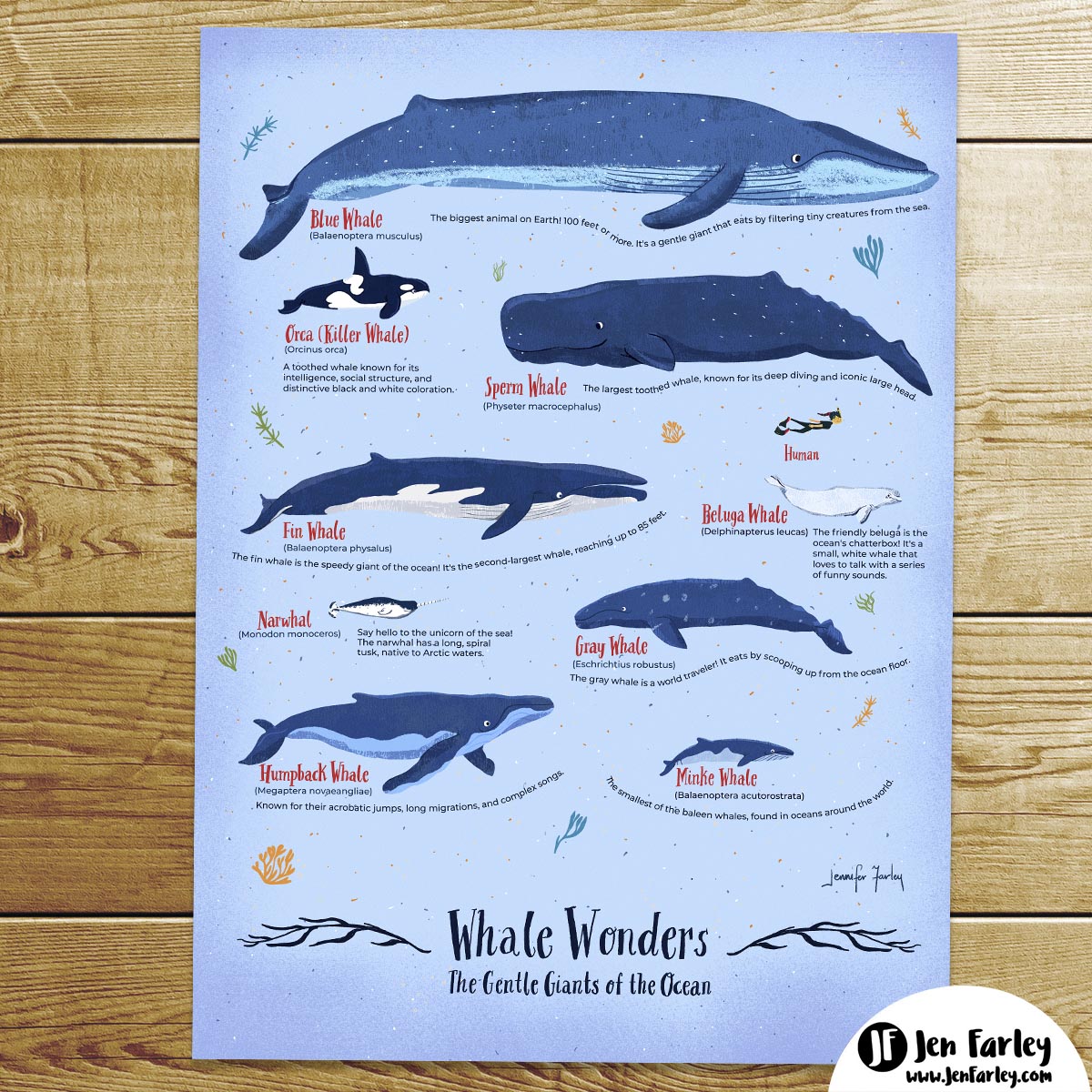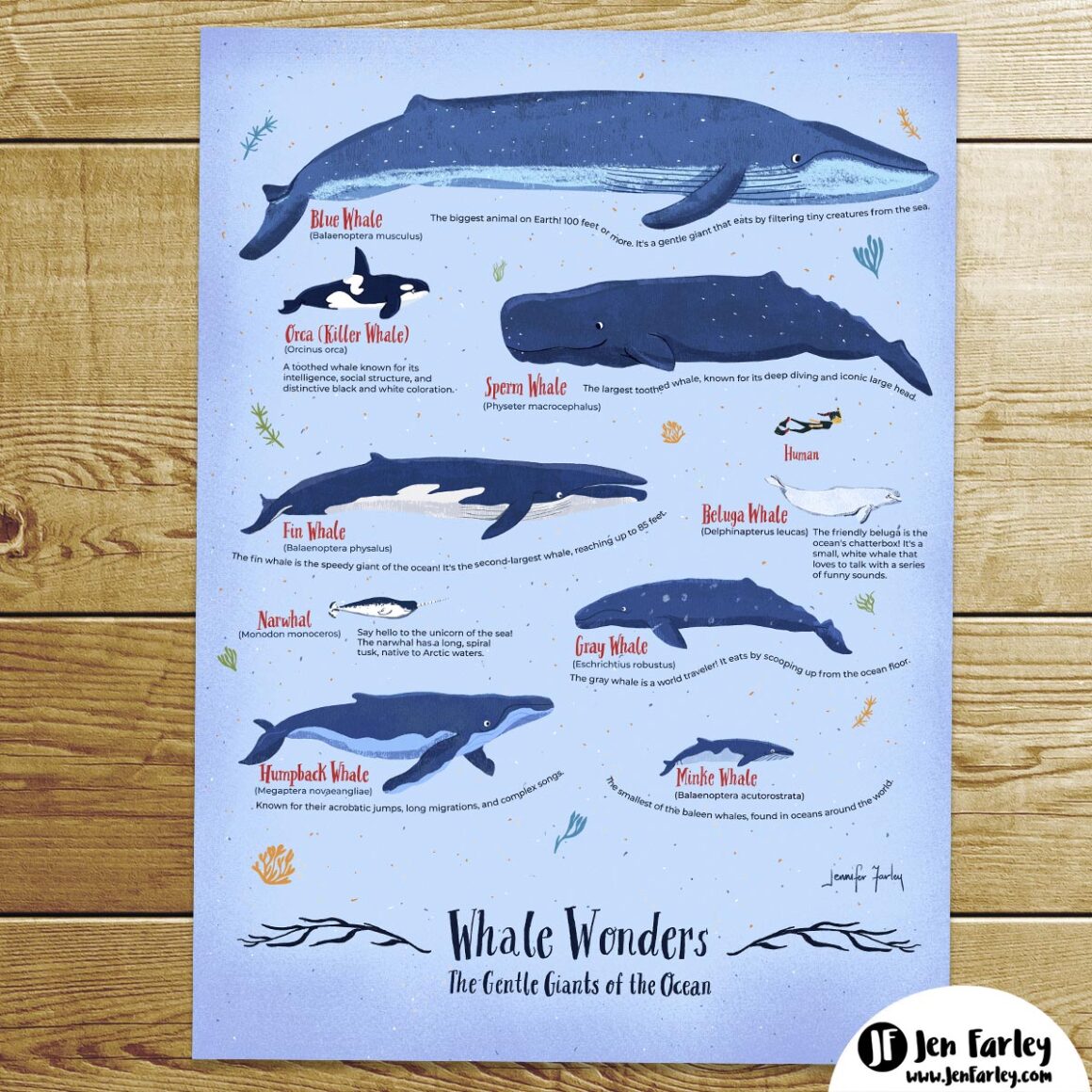
The whale art chart showcases nine whales, starting from the largest Blue Whale, down to one of the smaller whales – the Narwhal.
You can buy this whale chart as an art print from my shop.
Each whale has its own distinctive characteristics and behaviors.
Read on to find out more about these incredible creatures and see illustrations of each whale included in the chart.

The Blue Whale

Top of the Whale Chart is the stunning Blue Whale. It is the largest animal on Earth, growing up to 100 feet long and weighing as much as 200 tons. They have a distinct bluish-grey colouration and are known for their long, slender bodies and small dorsal fins. Blue whales are filter feeders. They consume massive amounts of krill by taking in huge mouthfuls of water and then using their baleen plates to filter out the krill.
These gentle giants are known for their impressive migration patterns, travelling thousands of miles between feeding and breeding grounds. Blue whales have unique feeding habits. They primarily feed on krill by lunging forward with their mouths wide open to engulf large quantities of these tiny crustaceans. Conservation efforts for blue whales are essential due to their endangered status. There are measures in place to protect them from threats such as ship strikes and entanglement in fishing gear.
Blue whales communicate through various techniques, including producing low-frequency sounds that can travel long distances underwater. These vocalizations are important for mating rituals, locating food, and maintaining social connections. In the ecosystem, blue whales play a crucial role in maintaining the balance of marine life. They do this by controlling the population of krill. Their massive size and feeding habits help regulate the krill population, preventing overgrazing that could disrupt the ocean’s delicate food chain.

The Sperm Whale

The Sperm Whale is one of the largest toothed whales. They can grow up to 59 feet long and weigh as much as 45 tons. These majestic creatures primarily feed on squid but also consume fish and even sharks on occasion. Their communication involves a complex system of clicking sounds known as echolocation, which they use to navigate and hunt in the deep ocean where they reside.
Sperm Whales are found in oceans worldwide, preferring deep waters. They can dive to incredible depths of up to 3,280 feet in search of food.
Unfortunately, these magnificent creatures face various conservation threats, including pollution, habitat degradation, and entanglement in fishing gear.
Efforts to protect the Sperm Whale include conservation initiatives focused on reducing human impacts on their habitats and populations. This will help to ensure the continued survival of these remarkable marine mammals.

Orca (Killer Whale)
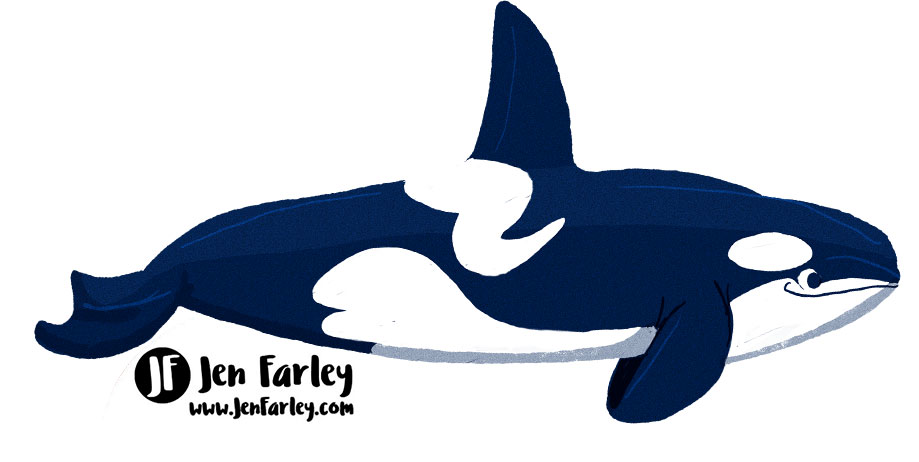
Orca behavior is characterized by their outstanding hunting abilities and intricate social structures. These whales eat a varied diet, preying on fish, seals, and even other whale species.
Their communication is complex, utilizing a mix of clicks, whistles, and calls to interact and coordinate within their pods.
Killer whales inhabit oceans globally, from the Arctic to the Antarctic, demonstrating adaptability to different environments.
In recent years, conservation efforts have intensified to protect Orca populations. Threats such as pollution, overfishing, and habitat degradation have led to a decrease in their numbers. Conservationists focus on safeguarding their habitats and food sources, and reducing human disturbances like boat traffic and noise pollution. By raising awareness and implementing stricter regulations, initiatives aim to secure the survival of these magnificent creatures for future generations.

Beluga Whale
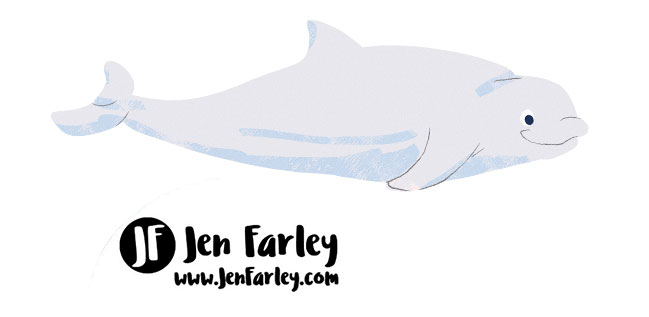
Gracefully gliding through Arctic waters, the Beluga captivates with its striking white colouring and melodic vocalizations. Belugas, also known as the ‘canaries of the sea,’ because of their “singing” voices are highly social creatures. Their behaviour includes playful interactions, synchronized swimming, and even the care of injured or sick members in their pods. These whales inhabit the cold, icy waters of the Arctic and sub-Arctic regions, where they rely on sea ice for feeding, resting, and calving.
Belugas are excellent communicators. They use a diverse range of sounds such as clicks, whistles, and clangs to navigate, locate food, and socialize with other members of their pod. Despite their adaptability, Belugas face threats from pollution, habitat degradation, and climate change. Conservation efforts are imperative to protect these unique whales and their habitats.
Their diet consists mainly of fish such as cod, herring, and shrimp, adapting to seasonal availability. By understanding and safeguarding the Beluga’s behavior, habitat, communication, conservation needs, and diet, we can guarantee the preservation of these enchanting marine mammals.


Buy The Illustrated Whale Chart
The whale chart showcases nine whales. From the largest Blue Whale, down to one of the smaller whales – the Narwhal.
You can buy this whale chart as an art print from my shop.
Featuring all nine of the whales I’ve written about here. The whales are all hand-drawn by me, Jennifer Farley.
These prints make fab wall-decor for nature lovers big and small.
Fin Whale

Known for their impressive migration patterns, Fin Whales travel great distances between their feeding and breeding grounds. Their adaptability to various marine environments is amazing. These magnificent creatures have a diet mainly consisting of small schooling fish, krill, and plankton.
One of the unique features of Fin Whales is their distinct vocalizations, which can be heard over long distances underwater. These calls are believed to be important for communication, navigation, and possibly mating purposes. Physically, Fin Whales are streamlined with a sleek body, allowing them to reach impressive speeds when swimming. Their long, slender bodies and distinctive chevron markings on their underside are physical adaptations that aid in their survival in the vast ocean environment.
Conservation efforts are vital for the protection of Fin Whales. They’ve faced threats from commercial whaling in the past, emphasizing the need for continued conservation measures to guarantee their survival.

Narwhal
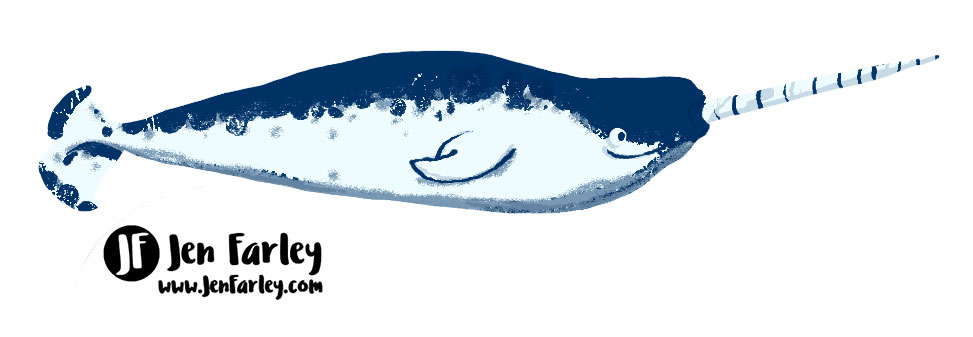
The remarkable Narwhal, known for its unique spiral tusk, inhabits Arctic waters. It belongs to the same toothed whale family as the Sperm Whale. The Narwhal’s tusk is actually an elongated tooth that protrudes from the left side of its upper jaw. This ‘unicorn of the sea’ is famous for its iconic spiral tooth, which can grow up to ten feet long.
Living in the icy Arctic habitat, Narwhals are known, (or maybe somewhat unknown) for their mysterious behaviour. They often dive to great depths in search of food, such as fish and squid. Their ability to dive deep and stay submerged for extended periods makes them fascinating creatures to observe. Despite their elusive nature, Narwhals are social animals, often seen travelling in groups called pods.
The Narwhal’s unique tusk has sparked many legends and myths throughout history, adding to the allure of this marine mammal.

Gray Whale

With its distinctive mottled gray coloring and bumpy appearance, the Gray Whale stands out among its marine counterparts. These whales are known for their impressive migration patterns. Known to travel up to 12,000 miles round trip between their feeding and breeding grounds. Gray Whales are baleen whales, using comb-like plates in their mouths to filter out small organisms like shrimp from the seafloor.
In terms of reproductive behaviors, Gray Whales give birth in warm, shallow waters, with a single calf born after a gestation period of about 13 months. Conservation efforts have been put in place to protect these creatures. They were once on the brink of extinction due to commercial whaling. Today, their populations have shown signs of recovery due to these conservation measures.
Historically, Gray Whales have played a significant role in the ecosystem and human culture. Indigenous communities along their migration routes rely on them for sustenance. Understanding and protecting these majestic creatures remain essential for the health of our oceans.

Humpback Whale
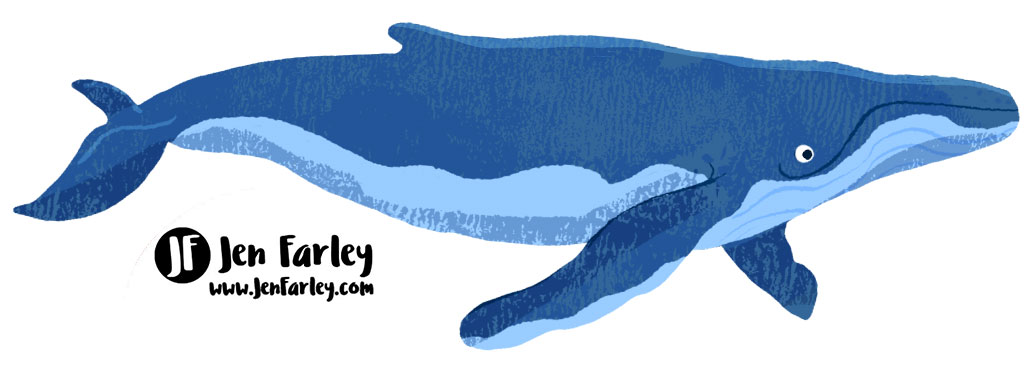
Known for their mesmerizing acrobatic displays and haunting songs, Humpback Whales captivate both researchers and whale watchers alike. These majestic creatures are known for their extensive migration patterns, traveling thousands of miles between their feeding and breeding grounds. One of the most fascinating behaviors of Humpback Whales is their singing behavior. Males sing complex songs that can last for hours.
Conservation efforts are essential for the protection of Humpback Whales. Threats such as entanglement in fishing gear and collisions with ships regularly harm them. Understanding their feeding habits is necessary for their conservation. They primarily feed on krill and small fish by using a technique called bubble-net feeding.
When it comes to breaching techniques, Humpback Whales are famous for their spectacular leaps out of the water. They are seen often spinning or twisting before crashing back into the sea. These breaching displays are believed to serve various purposes, from communication to removing parasites. Studying these magnificent creatures further is crucial for ensuring their survival in the oceans.

Minke Whale

When observing the vast ocean, you may catch a glimpse of the agile and elusive Minke Whale. Minke whales can be found in various habitats, from coastal areas to open oceans. These whales are known for their curious and sometimes solitary behavior, often approaching boats to investigate them.
Conservation efforts for Minke whales focus on reducing threats such as entanglement in fishing gear and ship strikes. Efforts are also made to safeguard their habitats and monitor their populations to guarantee sustainable numbers.
Minke whales are baleen whales that primarily feed on krill, small fish, and plankton by filtering large amounts of water through their baleen plates. Their migration patterns vary, with some populations traveling long distances between feeding and breeding grounds.
Population trends of Minke whales aren’t as well-known compared to other whale species, but they’re generally considered stable. Continued research and monitoring are essential to better understand and protect these fascinating creatures.

And that’s a wrap …
I’ve really enjoyed researching and drawing these nine sublime creatures as part of this illustration project. The sheer size, beauty, and diversity of these mammals is astonishing. I hope you’ve enjoyed reading and checking out the illustrations.
Here are some links to whale conservation organisations you may be interested in:
- WDC – Whale and Dolphin Conservation
- Irish Whale and Dolphin Group
- WWF – World Wildlife Fund Whale and Dolphin Conservation


Buy The Illustrated Whale Chart
The whale art chart showcases nine whales, starting from the largest Blue Whale, down to one of the smaller whales – the Narwhal.
You can buy this whale chart as an art print from my shop.
Featuring all nine of the whales I’ve written about here. The whales are all hand-drawn by me, Jennifer Farley.
These prints make fab wall-decor for nature lovers big and small.

